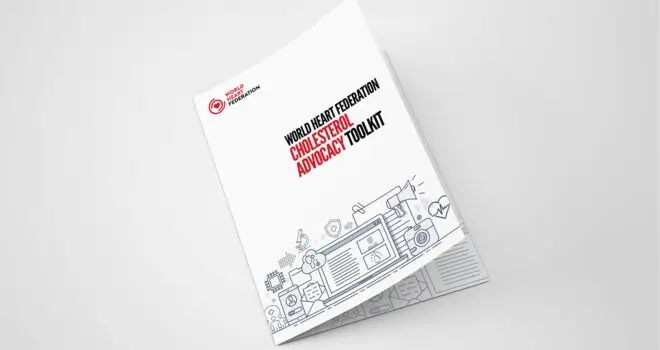Increasingly, evidence is equipping us with ways to manage our blood cholesterol levels that can mitigate or prevent dangerous cardiovascular conditions. The updated World Heart Federation Roadmap for Cholesterol delves into the epidemiology, diagnosis, treatment, and policies for better outcomes and highlights implementation case studies. The Roadmap focuses on approaches to reduce atherosclerosis and atherosclerotic cardiovascular disease (ASCVD) from cholesterol plaque that causes arteries to become thick or stiff. The 2022 Roadmap identifies challenges to prevention and management of cholesterol while providing evidence-based solutions.
As much as 85% of the 18 million cardiovascular deaths annually is due to ASCVD. Left untreated, elevated levels of unhealthy cholesterol (low-density lipoproteins or LDL-C) can lead to atherosclerosis. Advancing quietly, symptoms of atherosclerosis can erupt suddenly and often fatally. Premature death, disability and high healthcare expenditure are attributed to ASCVD which drives heart disease, stroke, and other complications of the circulatory system – our blood vessels.
“We have effective and inexpensive therapies to target atherosclerosis. We have identified solutions for implementing adequate therapies tailored to different models of care to ensure success,” said Raul D. Santos from the University of Sao Paulo and Hospital Israelita Albert Einstein, co-chair WHF Cholesterol Roadmap.
Lifestyle and genetics
Globally, raised total cholesterol (≥5.0 mmol/L) affects approximately 39% of adults. Lifestyle plays a key role in cholesterol levels. A diet high in saturated fat and trans-fats combined with physical inactivity and smoking can cause cholesterol levels to soar. Lifestyle-impacted metabolic conditions including type 2 diabetes and obesity also increase unhealthy cholesterol in the blood stream.
Heredity can play a partial role in the amount of cholesterol our bodies produce. Moreover, a genetic disorder called Familial Hypercholesterolemia (FH) affects approximately 28 million people worldwide (one in 311 people), a figure possibly much higher due to low awareness and under-diagnosis. Only 5-10% of those affected by FH know about their condition and less than 3% are adequately treated.
Most patients globally do not have a low-enough level of LDL-C that would minimize their risk of ASCVD. Obstacles to managing cholesterol often include lack of health awareness and education, insufficient or delayed screening, poor access to health facilities and health professionals, and unaffordability and unavailability of essential treatments.
Inadequate management of cholesterol can also be partly due to the under-use of effective doses of potent statins as first-line therapies, low use of combination therapies and poor adherence to lipid lowering regimens. Cultural biases often persist and include patients’ fear of side effects of treatments such as statins.
Prevent, detect, manage
Primary prevention is about treating risk factors to prevent ASCVD; primordial prevention is about avoiding the development of risk factors in the first place – those that arise from environmental and social conditions present from birth and that continue depending on lifestyle.
Awareness and education campaigns, food labelling and regulation, tobacco legislation, and taxing unhealthy commodities are some concrete steps that must be ramped up. Reinforcing ASCVD risk assessment processes, screening, genetic testing such as for FH, and national monitoring of outcomes are part of a robust package to promote healthy societies and end premature loss of life from treatable causes.
Timing matters for interventions to take effect. For example, started early, population-level screening can identify at-risk individuals and is important for a full picture of total blood fats such as cholesterol: LDL-C, non-HDL-C as well as triglycerides and lipoprotein (a), another type of blood fat or lipid. Increased health literacy for both public and healthcare providers is essential and can help promote patient adherence to therapies once risks have been identified.
“Our goal is to work together to reduce deaths from atherosclerotic cardiovascular diseases, and to curb human suffering and societal and fiscal costs. The knowledge gathered helps us provide pragmatic solutions via the WHF Cholesterol Roadmap, including a lifetime cholesterol-lowering approach,” said Professor Kausik K Ray of Imperial College London, co-chair WHF Cholesterol Roadmap.
Global implementation, national commitment
In tandem with clinical approaches are the critically important enabling health policies. Strong national policy is the bedrock that allows for implementation of increasing knowledge and evidence, effective drug treatment, and modified lifestyles so that all who need care get care.
From Europe to Asia, efforts have been underway to roll out guidelines in lipid management. In Belgium, a National Stakeholder Roundtable was convened leading to agreement for more systematic screening for FH in EU countries. Collaboration with the Colombian Society of Cardiology and Cardiovascular Surgery led to priorities including implementation of cholesterol clinical guidelines in all healthcare settings in the country. A National Roundtable in the Philippines resulted in a plan of action for patient screening, better education and guidelines, and access to health facilities by poor or remote populations. Similarly, Saudi Arabia identified a series of country-specific roadblocks to better CVD management at patient-, clinician- and healthcare system- levels, a precursor to proposed solutions for submittal to the national health council.
We have increasing knowledge, more drug therapies, and the proof that lifestyle modifications can tackle ASCVD. As the Cholesterol Roadmap 2022 shows, preventing the risks of cardiovascular disease due to cholesterol plaque build-up that cause atherosclerosis is a goal with possibly even more solutions than obstacles to achieving it.
The WHF Roadmaps summarise recommendations for reducing the burden of CVD, developed with the expertise of peers and co-chairs of the process. They identify obstacles to implementation and propose solutions, tools, and strategies for adaptation to diverse contexts. WHF Roadmaps encourage analysis based on tools such as WHF CVD Scorecards, facilitate roundtables, and enable implementation plans. WHF Roadmaps empower our Members such as CVD foundations, societies, and patient associations, to undertake and adapt initiatives with diverse stakeholders, such as:
- Governments and policymakers
- NGOs, health activists and advocates
- Healthcare professionals
- Corporate entities
- Academic and research institutions
- Patients and patient groups
WHF is grateful to Amgen and Novartis for their support in the development of the WHF Roadmap for Cholesterol 2022.


